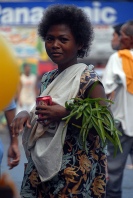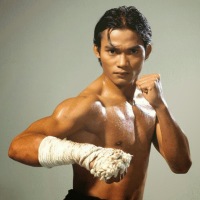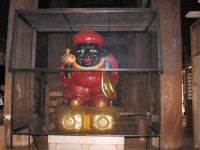They’re the people native to the eastern & southeastern parts of Asia. This sounds pretty straightforward, but the ones we’re used to are not the originals. The first ones were the ones we call negritos (Spanish & Portuguese for “little ‘black’ people”), or orang asli (Malay for aboriginal/ original people). They’re thought to have been among the OOA (out of Africa) migrants of ~60-70,000 years ago, and were the predominant people there up to about 5,000 years ago. However, only a few (~148,000 as of 2008!) remain across the region, and they’re the most disadvantaged & marginalised ones. Why is that not a surprise?
 |
| aboriginal man from Kuala Tahan, Malaysia |
 |
| Orang asli meeting, 2012 |
 |
| Aeta woman, Philippines |
 |
| Mangyan girl, Philippines. Blue eyes do not come as standard |
According to geneticists their mtDNA (mitochondrial DNA) contains the same DNA sequence groupings as found in the natives of New Guinea and Australia – haplogroup M. From this some reckon they were thus the ancestors of Dravidians (India), Papuans & Melanesians (New Guinea), Aborigines (Australia), present day negritos (south east Asia), and even the South American palaeoindians (more accurately called palaeoamericans). They’re called negritos because of their height – the men only just about reach 5 feet. This is similar to the pygmies of central Africa, and the first Europeans who met them assumed they were recently-arrived pygmies. Nevertheless, they are genetically among the most distant people to Africans thus the similarities are only superficial. It’s thought they became that short to cope better with limited food & resources, a phenomenon called island dwarfing.
It’s been shown that the first 2 dynasties of China were founded by ‘black’ people, specifically the Xia & Shang people. The latter were eventually beaten in battle by the Zhou, one of the ‘white’ groups originally from central Asia.* Other ancient ‘black’ Asians founded their own civilisations, kingdoms & ruling systems, including the Mon (Thailand, formerly known as Siam), Khmer of the Funan kingdom (Cambodia), Champa (Vietnam) and others.
* Yes, the ancient Chinese have descriptions of red/yellow-haired blue-eyed people entering their lands. They still exist here and there, especially the Hmong group (China, Thailand, Laos & Vietnam) for whom blond & red hair is common:
 |
| Hmong boy |
 |
| Ginger Tibetan girl |
 |
| Hmong girl |
 |
| Chinese Kazakhs |
The present-day Austronesians started arriving in southeast Asia and the Pacific islands about 8000 years ago, originating from Taiwan, and began to displace the natives. Same with the ‘mongoloid’ Han, who came to China from Tibet about 5000 years ago. Now China is almost 92% Han, Japan is 98.5% Nihonjin, and Vietnam is ~86% Viet. However, there was some mixing between the ‘mongoloids’ and negritos so every so often you’ll see some who more strongly resemble the aboriginals. That may explain why Thais are often darker than Chinese, who are often darker than Japanese. Funnily, just like India Thailand also has a general north-south colour division, the northerners (Kon nua) tend to be lighter than southerners (Kon thai) & north-easterners (Isarn).
.jpg) |
| Chinese Muslims. Most Chinese Muslims are not Han but Hui,
said to have some Arab blood in them |
 |
| Thai actor Tony Jaa flaunting his muscles |
On top of that, you also have those with ‘white’ European ancestry from the days of colonialism. That’s why so many Filipinos have Portuguese/ Spanish names, and all Malaysians speak English (so said a taxi driver I met in Malaysia. He said English was the only thing the Brits left them with post-colonialism, and any Malaysian who claims they can’t speak English is lying).
A little known fact is that Austronesians also migrated to Africa about 1500-2000 years ago. That’s why the Malagasy people of Madagascar have southeast Asian ancestry in addition to Bantu, and their language is predominant on the island.

The present-day ‘mongoloids’ didn’t merely ignore the originals. They acknowledged their existence since they first encountered them. The Chinese call them Kunlun (which translates as “little ‘black’ people”). One appears as the hero in Kunlun Nu (The Kunlun Slave), a wuxia romance novel written by Pei Xing during the Tang dynasty. The Kunlun, named Mo Le, had supernatural powers – gravity defiance & immortality which he used to protect his slaver Cu’s lover from becoming part of a court official’s harem. (Wuxia means martial hero) Prince Liu-Nan who died in 122 BC spoke of a kingdom of ‘black’ midgets in south-western China. The very first samurai & shogun, Sakanouye no Tamuramaro, was a ‘black’ man though it’s uncertain of what ethnicity he was – maybe Champa or Jōmon? It’s from him & his achievements that this Japanese proverb came (note there are 2 versions of the proverb, both of which are listed here):
For a samurai to be brave, he must have a bit of black blood.
Half the blood in one’s veins must be black to make a good samurai.
 |
| Google Sakanouye no Tamuramaro and you may find this pic. |
But even in Japan (where his ‘blackness’ is often hidden) he’s depicted more like…
 |
| …THIS |
However, orang asli are not one homogenous group. There are several distinct tribes and subgroups. Malaysia recognises 18, grouped into 3 main groups according to their cultures & languages:
Semang, who mostly now live in the north. Their languages are in the Aslian branch of the Austroasiatic family. The ones in the lowlands are sometimes called sakai, meaning slave or dependent (because despite slavery officially ending in 1884 it still carries on today!), which they find deeply offensive;
Senoi/ Sengoi/Sng’oi, mostly in the centre at present. Their languages are also Aslian, and they’re believed to have originally come from Thailand ~4500 years ago;
Melayu asli/ Melayu purba, generally confined to the south. Despite their group name (which translates from English proto-Malay), they have mixed heavily with Senoi, Semang and other people for centuries. Their ancestors were known to have been avid seafarers, sailing between Madagascar and New Zealand, and had sailed and worked alongside Arabs, Persians & Chinese for almost 2000 years.
 |
| woman from Jahai, a tribe in the Semang group |
| Senoi children |
 |
| proto-Malay woman |
(pink stars added by me)
And those are just in Malaysia. Other negritos in east/ southeast Asia include the Mani/ Maniq (Thailand), Aeta/ Agta (Philippines), Ati (Philippines), Mamanwa (Philippines), Andamanese (Andaman islands), and many others. Other aboriginal groups exist, who probably wouldn’t be classed as negrito/ orang asli but are still worth mentioning – the Ainu (Japan, though most are now heavily mixed), Tsou (Taiwan), Bunun (Taiwan), Jōmon (Japan) and Koropokkuru (Japan, came before the Ainu).
Finally, there’s a Filipino drama called Nita Negrita. Though its intent sounds good (to portray a dark-skinned girl as a respectable protagonist with ambitions that she achieves despite discrimination), the title is a misnomer. She’s not a negrita, neither the character nor the girl who plays her (Barbara “Barbie” Forteza). The character is mixed Filipina & Afro-American, the actress is ‘mongoloid’ Filipina. Add to that the fact that Nita was originally portrayed as literally black-skinned, which caused viewers to complain because she too strongly resembled blackface. Thus she was toned down to dark brown – an actual human skin colour. As with south Asians, east/southeast Asians have a history of denigrating dark-skinned people (even their own). This might stem from the Zhou’s Mandate of Heaven, a decree that battle victors (Zhou) bear divine right to rule over “morally corrupt” losers (Xia & Shang), or from their history of associating dark skin with working outdoors on the fields & therefore being poor. Just like in south Asia.
 |
| original |
 |
| new |
 |
| REALblasian girl (half ‘black’ American half Chinese), model Lou Jing.Barbie, take note! |

Yes, H’Mong oral history mentioned that when H’Mong arrived into China Dark skin Asian already live there. There were wars between dark skin Asian and Light skin Asian (H’Mong). During all these years of wars and intermixed it formed the Asian we know as today. It is also said that when H’Mong loss the war in China, it was easy for Mab (Man), Yi and Suav (Chinese) to indentify who the H’Mong were based on their clothes and skin color and hair. Let me remind everyone that the H’Mong were Mab (Man) it is not the same as Chinese were for Man. In Chinese Man mean Barbarian, in H’Mong Mab (Man) mean native, example “Mab liab Qab” meaning the naked natives. Dark skin Asian, H’Mong call them Daum (Dow) mean a person with dark complex skin. We call those people Mab Daum, these group include like Laotian, Vietnamese, Cambodia, Thai, Burmese these are groups with dark skin complex.
LikeLike
Spot on with this write-up, I truly believe that this website needs much more attention. I’ll probably be returning to read through more, thanks for the info!
LikeLike
Hey there just wanted to give you a quick heads up.
The words in your article seem to be running off the screen in Opera.
I’m not sure if this is a format issue or something to do
with web browser compatibility but I thought I’d post to let you know.
The style and design look great though! Hope you get the issue solved soon.
Thanks
LikeLike
That’s also because Portugal did discover multiple countries. They did discover East Timeor aling with Southern India making the people with blue and green eyes. People should credit how much the Portuguese people has conquered.Spain stole many countries from Portugal like: Cuba, Honduras, Costa Rica and more.
LikeLike
@ Elle,
Hi. Thanks for your comment but I’m slightly confused as to which point specifically you’re referring to.
LikeLike